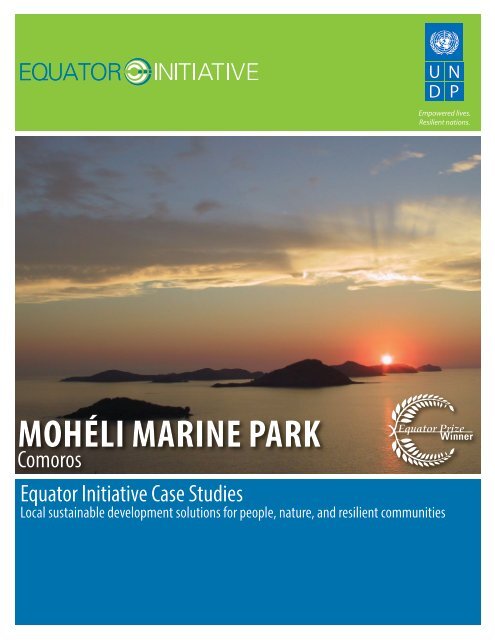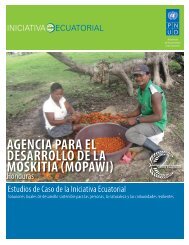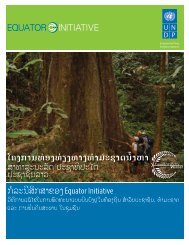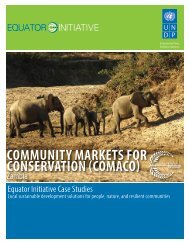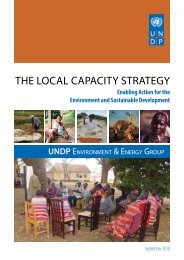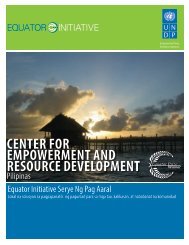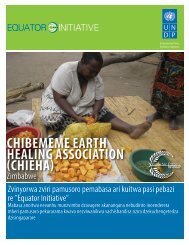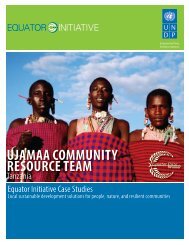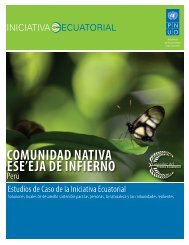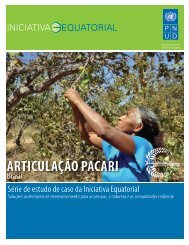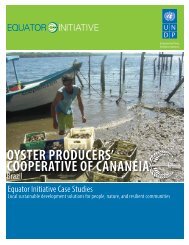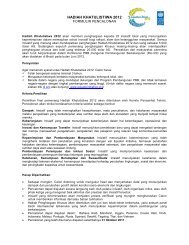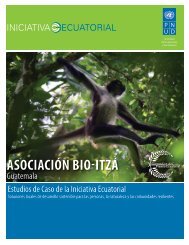MOHÉLI MARINE PARK - Equator Initiative
MOHÉLI MARINE PARK - Equator Initiative
MOHÉLI MARINE PARK - Equator Initiative
You also want an ePaper? Increase the reach of your titles
YUMPU automatically turns print PDFs into web optimized ePapers that Google loves.
Empowered lives.Resilient nations.<strong>MOHÉLI</strong> <strong>MARINE</strong> <strong>PARK</strong>Comoros<strong>Equator</strong> <strong>Initiative</strong> Case StudiesLocal sustainable development solutions for people, nature, and resilient communities
UNDP EQUATOR INITIATIVE CASE STUDY SERIESLocal and indigenous communities across the world are advancing innovative sustainable development solutions that workfor people and for nature. Few publications or case studies tell the full story of how such initiatives evolve, the breadth oftheir impacts, or how they change over time. Fewer still have undertaken to tell these stories with community practitionersthemselves guiding the narrative.To mark its 10-year anniversary, the <strong>Equator</strong> <strong>Initiative</strong> aims to fill this gap. The following case study is one in a growing seriesthat details the work of <strong>Equator</strong> Prize winners – vetted and peer-reviewed best practices in community-based environmentalconservation and sustainable livelihoods. These cases are intended to inspire the policy dialogue needed to take local successto scale, to improve the global knowledge base on local environment and development solutions, and to serve as models forreplication. Case studies are best viewed and understood with reference to ‘The Power of Local Action: Lessons from 10 Years ofthe <strong>Equator</strong> Prize’, a compendium of lessons learned and policy guidance that draws from the case material.Click on the map to visit the <strong>Equator</strong> <strong>Initiative</strong>’s searchable case study database.EditorsEditor-in-Chief:Managing Editor:Contributing Editors:Joseph CorcoranOliver HughesDearbhla Keegan, Matthew Konsa, Erin Lewis, Whitney WildingContributing WritersEdayatu Abieodun Lamptey, Erin Atwell, Toni Blackman, Jonathan Clay, Joseph Corcoran, Larissa Currado, Sarah Gordon, Oliver Hughes,Wen-Juan Jiang, Sonal Kanabar, Dearbhla Keegan, Matthew Konsa, Rachael Lader, Patrick Lee, Erin Lewis, Jona Liebl, Mengning Ma,Mary McGraw, Gabriele Orlandi, Juliana Quaresma, Peter Schecter, Martin Sommerschuh, Whitney Wilding, Luna WuDesignOliver Hughes, Dearbhla Keegan, Matthew Konsa, Amy Korngiebel, Kimberly Koserowski, Erin Lewis, John Mulqueen, Lorena de la Parra,Brandon Payne, Mariajosé Satizábal G.AcknowledgementsThe <strong>Equator</strong> <strong>Initiative</strong> acknowledges with gratitude the Mohéli Marine Park. All photo credits courtesy of Mohéli Marine Park. Mapscourtesy of CIA World Factbook and Wikipedia.Suggested CitationUnited Nations Development Programme. 2012. Mohéli Marine Park, Comoros. <strong>Equator</strong> <strong>Initiative</strong> Case Study Series. New York, NY.
<strong>MOHÉLI</strong> <strong>MARINE</strong> <strong>PARK</strong>ComorosPROJECT SUMMARYBetween 1998 and 2005, the Comoros island of Mohéliwas the setting for an initiative that brought togetherinternational organizations and local communitiesin creating a co-managed marine protected area.The idea was to conserve 404 square kilometresof ocean, home to key marine species such as thecoelacanth, humpback whales, dugong and dolphin,while benefiting local livelihoods through ecotourism.The result, the Mohéli Marine Park, is an ongoingexperiment in setting the right conditions for co-managedmarine management. Benefit-sharing arrangements andenforcement of harvesting regulations are key issues thathave affected the success of the initiative in recent years;early results in increasing live coral cover on the park’sreefs and increases in tourism numbers, however, indicatethat the park may yet be able to deliver on its promise.KEY FACTSEQUATOR PRIZE WINNER: 2002FOUNDED: 1995LOCATION: Mohéli islandBENEFICIARIES: 10 communities of southern Mohéli coastBIODIVERSITY: Mohéli Marine ParkTABLE OF CONTENTSBackground and Context 4Key Activities and Innovations 6Impacts 73
Background and ContextComoros is an archipelago island nation in the Indian Ocean, locatedoff the eastern coast of Africa, between Madagascar and northeasternMozambique. The country consists of the four islands in the volcanicComoros archipelago: Grande Comore, Mohéli, Anjouan, andMayotte, although the latter is politically administered by France asan overseas department. Comoros was declared independent fromFrance in 1975 and is one of the world’s poorest countries: in 2008,almost half the population of 798,000 lived on less than USD 1.25 perday. The islands have inadequate transportation links, few naturalresources, and a young and rapidly increasing population, whichhas been exacerbated in recent decades with an influx of Comorianswho were forced to leave Madagascar and Zanzibar.Environmental degradation and persistent povertyThe labour force is characterised by low levels of educationalattainment and high unemployment, while the country is heavilydependent on foreign grants and technical assistance. Agriculture,fishing, hunting, and forestry account for 40% of gross domesticproduct, employ 80% of the labour force, and provide most of thecountry’s exports. An over-reliance on subsistence livelihoods hascreated a vicious cycle of poverty and resource over-exploitation.Coastal communities on the island of Mohéli, for example, whichaccount for approximately 80% of the island’s population of 30,000,use poison and dynamite to maximise short-term fish catches,reducing fish stock in the long run and further contributing toincome poverty.Environmental degradation threatens Mohéli’s abundant biologicaldiversity; the island is a tropical paradise, home to more than 500species of plants, 21 species of birds, and nine species of reptiles.Flagship species for conservation include the endemic Livingstone’sFruit Bat (Pteropus livingstonii), a giant bat with a wing span of morethan one metre, that numbered only 1,200 individuals in 2003. Thebeaches are an important nesting ground for green sea turtles,while the waters surrounding it are home to the coelacanth, a rareprehistoric fish with limb-like fins that was thought to be extinctuntil 1938.Other key species include humpback whales, dugong, the Spinnerdolphin (Stenella longirostris) and Bottlenose dolphin (Tursiopstruncatus), corals, sea cucumbers, and the large gastropod Turbomarmoratus. The island is also home to Lake Bundouni, a Ramsarsite and the largest body of freshwater in the Comoros, which is anesting site for hundreds of migratory bird species.As well as the threats of species extinction, the island’s ecosystemshave also sustained damage from unsustainable land-use practices.Deforestation, increased agriculture on hillsides due to landshortages, and cattle grazing have resulted in severe soil erosionand runoff that have damaged the island’s coral reefs. Overfishinghas depleted stocks, while the search for building materials hasdestroyed mangrove forests and beaches that are essential breedinggrounds for turtles. Coral reefs have also suffered bleaching as aresult of the warming Indian Ocean.4
An international intervention to support local actionIn 1998, IUCN, the United Nations Environment Programmeand the Comorian government, with funding from the GlobalEnvironment Facility and United Nations Development Programme,initiated a five-year project entitled ‘Conservation of Biodiversityand Sustainable Development in the Federal Islamic Republic ofthe Comoros’ (typically shortened to ‘Project Biodiversity’.) Thisproject’s most notable achievement was the declaration of theMohéli Marine Park in 2001. This was the first protected area tobe gazetted in the Comoros, and was an attempt to counter thesocial, economic, and environmental threats of population growth,resource over-exploitation, and poverty by adopting a collaborativeand community-based approach to management of the marineresources upon which the islanders’ livelihoods depend.The establishment of the park represented the culmination of amulti-stakeholder process begun in 1993, when the governmentintroduced a National Environmental Policy designed to halt thespiral of environmental degradation. The policy introduced theidea of involving a broad spectrum of parties to marine and coastalmanagement, namely local resource users, non-governmentalorganisations, government departments, the private sector, andinternational donors. This was the first time the government hadsought to work with local communities in resource management.Consultations were held with coastal villages, aiming to bothidentify socioeconomic needs and to raise awareness of the needfor conservation.This process led, in 1995, to the ten communities that make up thesouthern coast of Mohéli advocating for the designation of theiroffshore waters as a marine protected area. These communities arehome to approximately 10,000 inhabitants. Meetings took placewith different stakeholders including fishermen, youth leaders andvillage elders to discuss collaborative management options for themarine park. The principle of “joint management” guided theseconsultations, in which communities were encouraged to negotiateand define the respective functions, rights and responsibilitiesof different stakeholders in the management of the park. Comanagementagreements were signed between the Comoriangovernment and each village community detailing the managementand regulation of the coastal and marine areas under the directresponsibility of the respective villages.Parc Marin de MohéliTogether, these ten community-managed marine reserves areincorporated within the Mohéli Marine Park, which was officiallygazetted on 19th April 2001. This Marine Protected Area covers404km2 of ocean extending from the southern coast of the island.The conservation area was chosen for its rich biological diversity,including the presence of key coastal coral and mangrove foresthabitats, and endangered marine species such as humpback whales,dugong, and a globally-important nesting site for the endangeredgreen sea turtle.5
Key Activities and InnovationsThe designation, establishment and management of the MohéliMarine Park was an important instrument in the Comoriangovernment’s sustainable development strategy, providing a rangeof benefits for fisheries, local economies and the marine environment,such as a safe haven for fish stocks to recover, an alternative sourceof income for local people through ecotourism, the prevention offurther coastal habitat damage, and the maintenance of globallyimportantbiodiversity.representatives of the member communities, and brings togetherthe government and local communities in a joint managementapproach. Two government officials provide support and technicalexpertise in administration and finance to the committee, whileoverall responsibility for the park resides with the Comoros Ministerfor Environment.While the management of the park falls within the government’sconstitutional responsibility, the daily regulation of local coastal areasis devolved to the community level. Regulations concerning marinezoning, boundaries, management, and local access are largely basedon consultations with villagers, fishermen, community groups, andresource users in each of the villages that lie within the protectedzone. For instance, regulations allow only traditional fishing methodswithin the park’s boundaries, prohibiting the use of fine mesh nets,dynamite fishing, and the destruction of corals. Village committeesare mandated to deal with cases of non-compliance, with casesreferred to the national judiciary if local solutions cannot be found.UNDP, UNEP and IUCN provided financial support and technicalassistance to train community volunteers as “eco-guards”, who areresponsible for awareness-raising as well as monitoring.As well as regulating fishing practices, the park management hasalso sought to develop sustainable livelihood alternatives to marineharvesting. The Comorian government provided co-financing for thedevelopment of income-generating activities proposed by villagedevelopment associations. A community that raised 50% of the costof a proposed livelihood activity, for example, received a matchinginvestment from the government of 50%. A community that raised30% of the total cost of its activity, meanwhile, received a matchinggrant of 30%, and the remaining 40% in an interest-free loan.A Park Management Committee oversees management of thepark. This consists of sixteen individuals, including ten elected6
ImpactsThe creation of the Mohéli Marine Park had tangible benefits forthe marine environment and its member communities in the earlyyears of its existence. For instance, coral health was seen to improvethanks to bans on destructive fishing practices. Between 1998 and2001, live coral cover on the park’s reefs increased from 30% to 65%.Other regulations regarding local access include bans on harvestingsea cucumbers, starfish, and crustaceans, as well as a ban on turtlepoaching. Turtle nesting sites were found at more locations on theisland’s southern beaches as a result.While the conservation of more than 400 square kilometres of oceanhas had visible benefits for the region’s endangered marine species,sustainable management regulations have also produced socialand economic gains for local communities. Government fundingfor sustainable livelihood projects facilitated the construction ofecotourism lodges by four community development associations.This led to the number of tourists visiting Mohéli to rise from 75tourists per village in 1998 to 140 in 2001. This has had spill-overeffects in terms of creating related livelihood opportunities forvillagers. Community members have been employed as guides,in building and managing accommodation facilities, and sellinghandicrafts. By 2002, the initiative reported the direct creation of 30new jobs for local people.Sustainable harvesting regulations on fishing allowed localfishermen to increase catch sizes. Between 1998 and 2002, catch sizenearly doubled from 160kg per month to over 300kg, benefitting250 fishermen working in the park. With increased revenues fromhigher fish catches, villagers were able to buy motor boats for use infishing, reserve surveillance, and tourism activities.Limits to long-term viabilityDespite the initial successes of the Mohéli Marine Park, it is currentlyoperating at a vastly reduced capacity. Although some componentsof ‘Project Biodiversity’ were extended for two years in 2003 underthe title ‘The Project for Rehabilitation Activities for the Conservationof Biodiversity’, all GEF-funded activities concluded in 2005.Since then, while the Mohéli Marine Park still nominally exists,the management of the park at the community level has beensignificantly eroded. Tourism numbers have declined dramaticallyfrom their initial levels, and lack of funding for monitoring andenforcement of park regulations has led to increases in poaching ofhigh-value species such as sea turtles.A study conducted in 2007 interviewed a large number of respondentsacross the park’s ten communities to assess its impact. All of the focusgroups agreed that the existence of the park was still important,7
citing its role in ensuring the conservation of marine and coastalbiodiversity, habitats and endangered species, encouraging thedevelopment of ecotourism and other income-generating activities;ensuring the sustainable use of marine resources; and reinforcingenvironmental education, training and communication. Thisdemonstrates that the project had been effective in communicatingits purpose and objectives to its target audiences; the extent oflocal disenchantment with the project arguably reflects, in part, thefailure to meet these high expectations. In particular, communityrespondents were often frustrated by the slow progress in seeingeconomic rewards from sustainable fishing that had been promisedby park officials.Although the survey respondents credited the park with eleven keyachievements, such as reducing environmental degradation, raisingenvironmental consciousness, and increased coral cover, they alsoidentified eighteen negative aspects of the park. These included itslack of sustainability, the lack of effective monitoring or enforcement,lack of respect for park personnel or official agreements, and poormanagement of equipment. Specific criticisms were directed atthe lack of communication between the park’s management andexternal actors: commercial harvesting of sea cucumbers had beencarried out within the park by foreign companies, for instance,while local community members were banned from harvestingthese commercially valuable species. There was also a widelyheldbelief that the park’s regulations had unfairly discriminatedagainst women, for instance in outlawing the use of uruva poison(Theophrosia candida) in fishing, an activity exclusively carried outby female fishers. Benefits of ecotourism were also not distributedequally across the ten communities; those that were marginalisedwere typically where the worst instances of poaching were seen.Lack of technical assistance and equipment was also highlighted:the promised introduction of Fish Aggregating Devices (FADs),which would have helped to increase fishing yields, was not carriedout, for example.The study identified six main contributing factors to the park’sdiminished effectiveness. These were: the inequitable distributionof benefits; the lack of sustainable livelihoods options; the failureto involve women in awareness-raising and leadership roles; thechallenges to effective monitoring and enforcement; the number ofenvironmental threats to biodiversity that remained; and the lack ofsustainability that undermined the management of the project.Lack of financial sustainabilityThis lack of sustainability was identified as the primary flaw in theMohéli Marine Park project. Although there were originally plans toaddress this, it seems that they were not fully realized by the park’smanagement team. ‘Project Biodiversity’ laid the groundwork for aBiodiversity Trust Fund for the Comoros that would have includedthe management of protected areas, but this failed to materialise.A much longer time-scale was required to set up the fund – severalyears, rather than the 4-5 years envisaged in the project document– as well as a much greater level of capitalisation: USD 15 millionwas required, rather than the USD 2 million proposed in the projectdocument. The management plan estimated annual managementcosts at between USD 87,000 and USD 215,000. In the absence ofthe Trust Fund to cover these costs, and no alternative means offinancing the project, the park’s financial situation was alreadyunclear by 2003. This led to reductions in management effectiveness,activity and levels of enforcement; following the end of funding,communities were no longer willing to accept the potential of lowcost,community-motivated conservation initiatives, preferring toleave enforcement to the salaried eco-guards. The study concludedthat community enthusiasm for conservation ‘was, in some ways,reduced by the creation of Parc Marin de Mohéli as stakeholdersbecame disillusioned by the lack of activity and realized benefitsfollowing Project Biodiversity.’A quote from a male respondent from the community of Ouallah 1sums up the challenges that now face the project and the difficultyof sustaining community enthusiasm for conservation initiatives inthe absence of institutional support:‘Since Project Biodiversity finished, we now say that the word Parc Marinde Mohéli does not exist. There has never been follow-up to anythingthat was implemented during the project. With the project, we stoppedall of the harmful activities that we were told to stop. However, we sawthat we gained nothing, and now, bit-by-bit, we have started engagingin harmful activities again. Moreover, the management of the ParcMarin de Mohéli now remains only in the hands of a few individuals –this is the reason that there is more damage occurring now than before– people have lost respect for Parc Marin de Mohéli. To make mattersworse, the eco-guards were abandoned as soon as the project financesstopped. They were expected to work hard and were paid very little. Forexample, they were expected to defend themselves against poacherscarrying weapons, without having any weapons themselves or eventraining in self-defence.’Looking to the futureDespite this, there remains a widespread desire to see the projectultimately succeed. Its importance for marine biodiversity and itspotential for improving local livelihoods are well-recognised. In thewords of another respondent from the community of Ndrondroni:‘We want youth to be involved with Parc Marin de Mohéli. We wantthem to become motivated and to forget about all the past negativeaspects associated with Parc Marin de Mohéli. We want them to be ableto gain the benefits. Our generation has failed, but we should look toimprove the situation for the following generations.’8
FURTHER REFERENCE• C3-Comores. 2007. ‘Stakeholders’ perceptions of Mohéli Marine Park, Comoros: Lessons learned from five years of co-management.’ C3Technical Report Series No. 4. ISSN 1754-5188. Community Centred Conservation (C3), London, UK.• Video on Mohéli Marine Park (Vimeo) vimeo.com/36989115Click the thumbnails below to read more case studies like this:<strong>Equator</strong> <strong>Initiative</strong>Environment and Energy GroupUnited Nations Development Programme (UNDP)304 East 45th Street, 6th FloorNew York, NY 10017Tel: +1 646 781 4023www.equatorinitiative.orgThe United Nations Development Programme (UNDP) is the UN’s global development network, advocating for change andconnecting countries to knowledge, experience and resources to help people build a better life.The <strong>Equator</strong> <strong>Initiative</strong> brings together the United Nations, governments, civil society, businesses and grassroots organizationsto recognize and advance local sustainable development solutions for people, nature and resilient communities.©2012 by <strong>Equator</strong> <strong>Initiative</strong>All rights reserved


